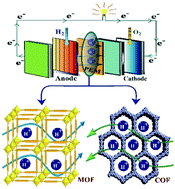Structural features of proton-conducting metal organic and covalent organic frameworks
Abstract
Proton-conducting materials have been gaining significant attention due to their applicability as solid electrolytes in proton exchange membrane fuel cells (PEMFCs). The confined architectural design and open space in metal organic frameworks (MOFs) and covalent organic frameworks (COFs) makes them attractive as proton-conducting materials for PEMFCs applications. They offer a high degree of structural tunability, well-defined accessible pores, good crystallinity, thermo/chemical stability, etc., which make them ideal proton conductors at various temperatures under hydrous and anhydrous conditions. In this article, we are reviewing the reported state-of-the-art porous crystalline proton-conducting materials (MOFs and COFs) with detailed insights into their conduction pathway/mechanism in relation to their unique structural features. Further, the design and synthetic principle of many well-known proton-conducting MOFs and COFs, including their operation under various conditions, will be discussed. At the end, a dedicated perspective section will be presented based on our learning experiences, which will definitely add a new dimension in the design of potential porous crystalline materials for conduction-related applications in the future.

- This article is part of the themed collection: 2020 Highlight article collection


 Please wait while we load your content...
Please wait while we load your content...